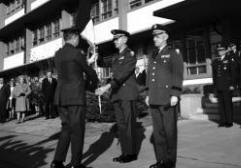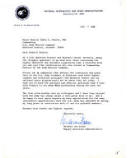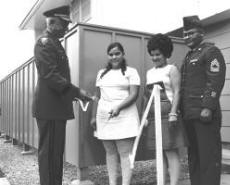Major General Edwin Donley
MG Edwin I. Donley was born on 9 May 1918 in Buchanan, Michigan. He graduated from the U.S. Naval Academy at Annapolis in 1940 with a bachelor's degree in engineering. In 1949, he earned a master's degree in industrial management from the University of Michigan. His military schooling included graduation from the U.S. Army Command and General Staff School in 1943; the U.S. Army Ordnance School in 1946; the Industrial College of the Armed Forces in 1961; and the U.S. Army Logistics Management Center in 1963.
General Donley entered the Army on 22 August 1941 as a Reserve Officer assigned to the Industrial Division, Office, Chief of Ordnance, in Washington, DC. He was reassigned in June 1942 as the Assistant Ordnance Officer of the 76th Infantry Division at Fort Meade, Maryland. After attending the Command and General Staff School from August to November 1943, he was reassigned to the 76th Infantry Division at Camp McCoy, Wisconsin, as the Assistant Ordnance Officer. He became Division Ordnance Officer in March 1944, a position he held until July 1945.
In the years following World War II, General Donley had a 3-year tour of duty with the U.S. Army, Caribbean Area, as Ordnance Officer; spent a year on loan to the State Department in the Office, Foreign Liquidation Commission; had two tours totaling 6 years with the Office, Chief of Ordnance in Washington, D.C.; and a tour as Executive Officer and Deputy Commander at Picatinny Arsenal, New Jersey. After completing the Industrial College of the Armed Forces in June 1961, he served in Korea with the Korean Military Advisory Group as Senior Supply and Maintenance Advisor to the Deputy Chief of Staff (Logistics), Republic of Korea Army.
General Donley first came to Redstone Arsenal as the PERSHING Project Manager, U.S. Army Missile Command (MICOM), in October 1963. In January 1966, he became the Deputy Commander for Land Combat Systems, serving in that position until January 1967. Later that year, he took command of the U.S. Army Mobility Equipment Command in Saint Louis, Missouri, until February 1968, when he was assigned as Commander of the U.S. Army Materiel Command in Europe. He then returned to Redstone Arsenal as the MICOM Commander, a position he held from 17 November 1969 to 31 October 1973.
General Donley is a recipient of the Legion of Merit (with one Oak Leaf Cluster), the Distinguished Service Medal, the Bronze Star Medal, the Army Occupation Medal (Germany), the American and National Defense Service Medals, the American Campaign Medal, the European-African-Middle Eastern Campaign Medal, and the World War II Victory Medal. He was inducted into the US Army Ordnance Corps Hall of Fame in1996.
He died on August 16, 2006.
Oral History Interview with MG Edwin I. Donley - January 13, 2005
This interview was conducted
as part of a project to capture the thoughts and
recollections of former commanders and community leaders as
to the relationship between Redstone Arsenal and the
Huntsville/Madison County Community. We used this
opportunity to find out about General Donley's distinguished
career at Redstone Arsenal and his very early roots with the
installation dating back to World War II. The interview
starts slow but as time went on General Donley told us some
great stories about some of the key players in Redstone
Arsenal's history.





